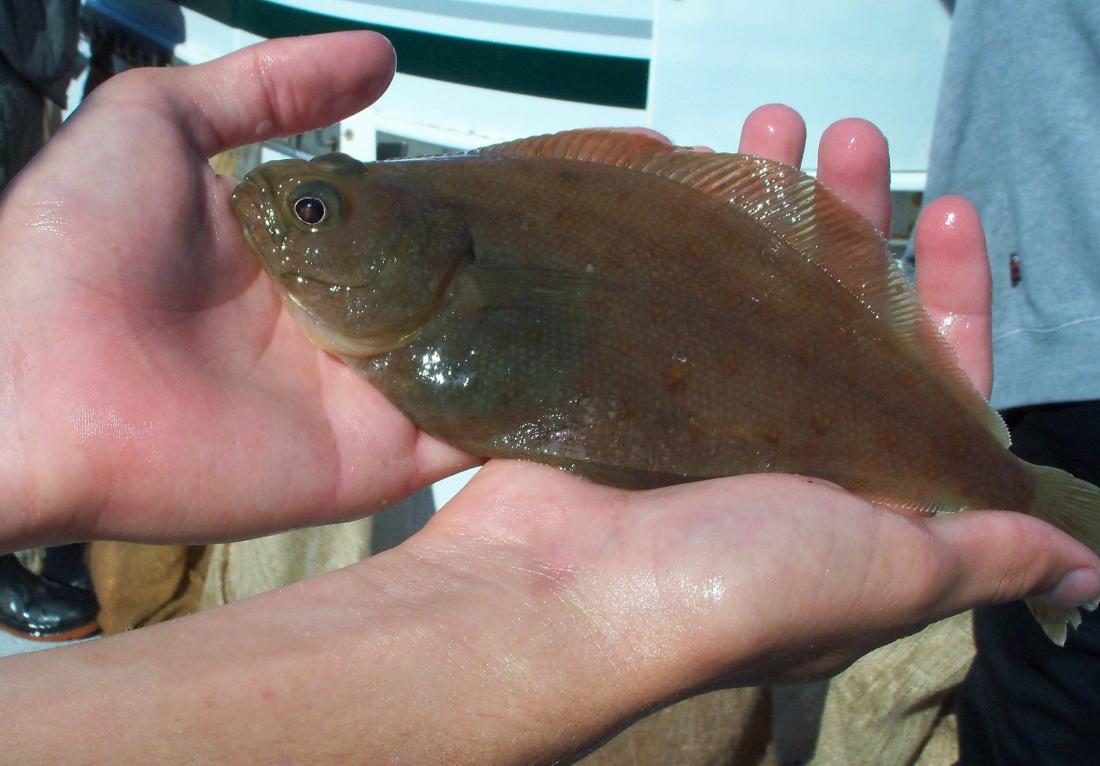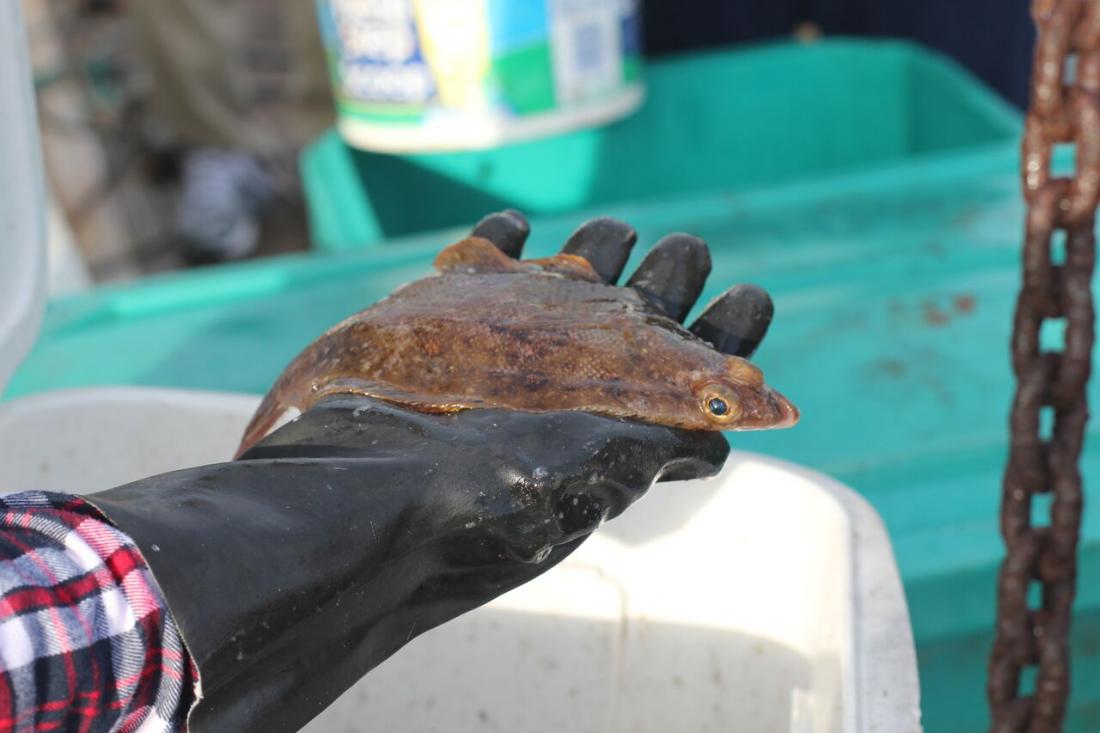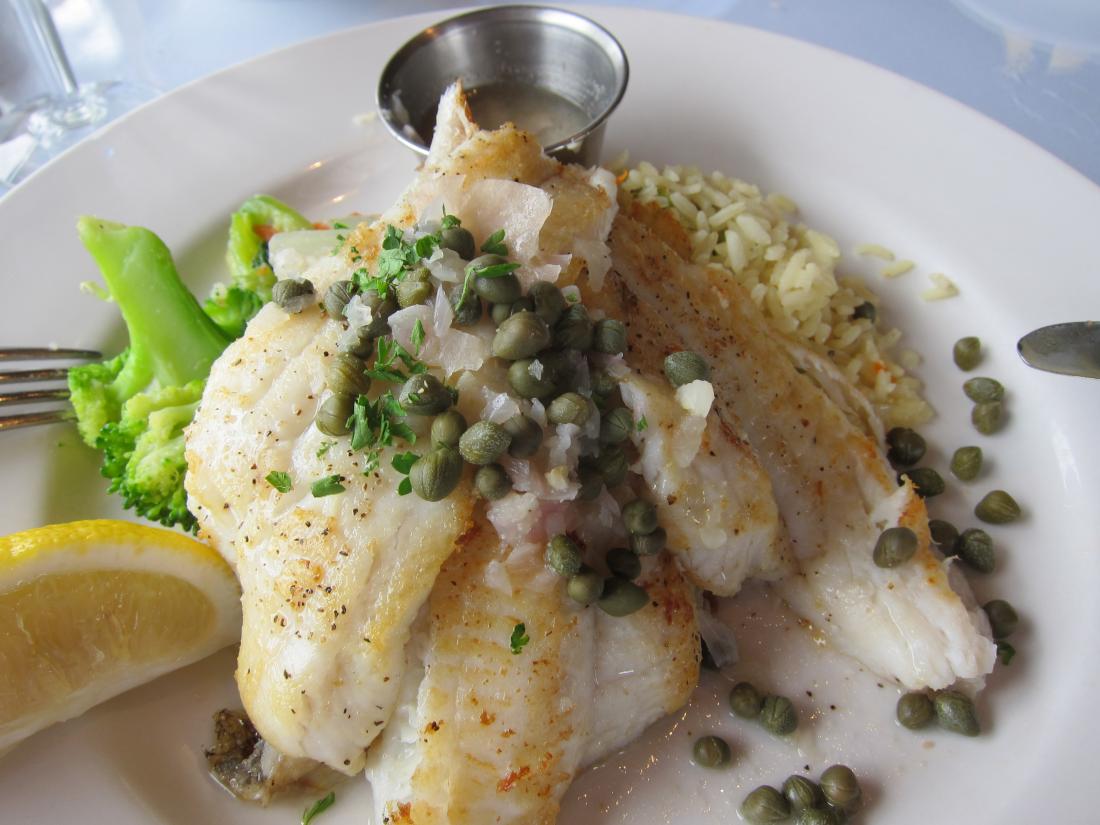Pacific Sanddab
Citharichthys sordidus
The Science
THE SCIENCE
Both eyes are on the left side of the Sanddab’s head. [1]

Taxonomic description
- A left-eyed flounder with brown, white, yellow and orange coloration on the eyed side, and white or light brown on the blind side. [1]
- Unlike other flatfish, has a straight rather than slightly curved midline. [1]
- Ranges from 5 inches (12.7 cm) to 16 inches (40.6 cm) in length, and can weigh up to 2 pounds (4.4 kg). [1]
Distribution
- Found in the Eastern Pacific from the southern tip of Baja California, Mexico to the Bering Sea. [1]
- Most abundant off North-central California and Southern California. [7]
Life history
- It lives up to 9-10 years. [4]
- Spawns multiple times over the spawning season from July to September, with the females producing numerous eggs each spawning session. [4]
- Pairs with one mate at a time and uses external fertilization. [4]
Habitat
- Lives on the seafloor in mostly sandy and muddy areas [5] at depths of 30 ft (9 m) to 1,800 feet (568 m), but is most prevalent between 120-300 feet (37-91 m). [1]
- Tends to live in shallow waters when young, and is found occasionally in tide pools. [4]
- Lives among various rays, crustaceans, cephalopods, other flatfish and bottom feeders. [5]
- Survives on a variety of small fish, cephalopods, eggs and crustaceans. [4]
- Often nestles into the soft seafloor to camouflage from predators, including sharks, rays and halibut. [6]
- Fished commercially and recreationally by humans. [6]
The Fishery
THE FISHERY
Pacific Sanddab is rarely the sole target for a given fishery, and is mostly caught by bottom trawl. [2]

Seasonal availability
- Available year-round, but with less frequency in winter. [10]
Regulatory and management authority
- Managed federally by the NOAA fisheries and, as established by the Magnuson-Stevens Act, the Pacific Fishery Management Council (PFMC) through the Pacific Coast Groundfish Fishery Management Plan (FMP). [8]
- As established by the Marine Life Management Act, the California Fish and Game Commission (CFGC) regulates the fishery in state waters, and the California Department of Fish and Wildlife (CDFW) manages this fishery. [12]
- The Groundfish Collective combines input from the industry and government entities to inform regulatory and/or management measures for this fishery. [13]
Gear type
- Fisheries that catch this species use bottom trawl. [9]
Status of the fishery
- No seasonal regulations in place—Pacific Sanddab is rarely the intended catch.
- Little concern about the stock which was estimated to be at 95.5% of its unfished level in 2013, well below the management target for flat fish. [2]
- The harvest rate has steadily declined over the last decade, meaning that fewer fish are being caught in relation to the year’s spawning rate. [2]
Potential ecosystem impacts
- Bottom trawl has the potential to capture bycatch and damage the seafloor; this species is mostly found in sand and mud which can recover relatively easily from trawling. [9]
The Seafood
THE SEAFOOD
This fish has sweet tasting meat but savory skin. It is said to taste like trout and French Fries, respectively. [3]


Edible portions
- Edible whole or as fillets. [3]
Description of meat
- Meat is sweeter than most other fish, akin to trout. [3]
Culinary uses
- Can be cut into fillets and deboned after cooking. [3]
- For a recipe for pan fried sanddab with olive oil, butter and light breading, visit 365 Whole Foods. [3]
- For a recipe for san dabs meuniere, visit Emeril Lagasse. [14]
- The skin can be left on (it tastes like fries). [3]
Nutritional information
- 1 fillet is considered a serving, roughly 100 grams. [11]
Toxicity report
- No known toxins.
Seasonal availability
- It is available year-round, but with less frequency in winter. [10]
References
[1] California Department of Fish and Wildlife. 2017. Web. www.wildlife.ca.gov/Fishing/Ocean/Fish-ID/Sportfish/Flatfishes. Accessed: 9 April 2017
[2] He, X. 2013. Status of the U.S. Pacific Sanddab Resource in 2013. National Oceanic and Atmospheric Administration, Santa Cruz, CA, United States. https://citeseerx.ist.psu.edu/viewdoc/download?doi=10.1.1.397.6953&rep=rep1&type=pdf.
[3] Nordahl, D. 2015. Pacific Sanddab (Citharichtys sordidus). www.365wholefoods.blogspot.com/2012/10/pacific-sanddab-citharichthys-sordidus.html. Accessed: 9 April 2017
[4] Fishbase. 2017. Web. www.fishbase.org/summary/Citharichthys-sordidus.html. Accessed: 17 April 2017
[5] Monterey Bay Aquarium. 2017. Web. www.montereybayaquarium.org/animal-guide/fishes/sanddab. Accessed: 17 April 2017
[6] Animalia Life. 2017. Web. www.animalia-life.club/fishes/pacific-sanddab.html Accessed: 17 April 2017.
[7] Fishsource. 2017. Web. www.fishsource.org/search?query=pacific%20sanddab. Accessed: 30 April 2017.
[8] Groundfish Fishery Management Plan. Pacific Fishery Management Council. 2017. Web. https://www.pcouncil.org/groundfish-fishery-management-plan-and-amendments/.
[9] Seafood Watch Consulting Researcher. 2014. Groundfish, California Groundfish Collective. Seafood Watch. Web. https://www.seafoodwatch.org/-/m/sfw/pdf/reports/g/mba_seafoodwatch_california_groundfish_collective_fishery_report.pdf. Accessed 8 Sept 2020.
[10] Seaforager. 2013. Web. www.seaforager.com/sand-dab. Accessed: 9 April 2017.
[11] Fish, Flatfish (flounder and sole), raw. n.d. Nutrition Data. Accessed: 21 September 2017. Web. https://nutritiondata.self.com/facts/finfish-and-shellfish-products/4054/2. Accessed 4 Sept 2020.
[12] Marine Life Management Act. n.d. California Department of Fish and Wildlife. Web. https://wildlife.ca.gov/Conservation/Marine/MLMA. Accessed 24 August 2020.
[13] The Nature Conservancy. 2015. The California Groundfish Collective. Web. http://www.cagroundfish.org/#our-story. Accessed 2 December 2020.
[14] Lagasse, E. Emeril Lagasse. n.d. Sand Dabs Meuniere. Web. https://www.emerils.com/125821/sand-dabs-meuniere. Accessed 19 January 2021.
[15] Wikipedia. 2006. Citharichthys sordidus. Digital image. Web. https://en.wikipedia.org/wiki/Pacific_sanddab#/media/File:Citharichthys…. Accessed 22 February 2021.
[16] nmoorhatch. iNaturalist. 2010. Digital image. Web. https://www.inaturalist.org/photos/77511397. Accessed 22 February 2021.
[17] Cross, J. flickr. 2011. Digital image. Web. https://flickr.com/photos/jaycross/6038675929. Accessed 22 February 2021.
[18] socal_angling, iNaturalist. https://www.inaturalist.org/observations/85689720



